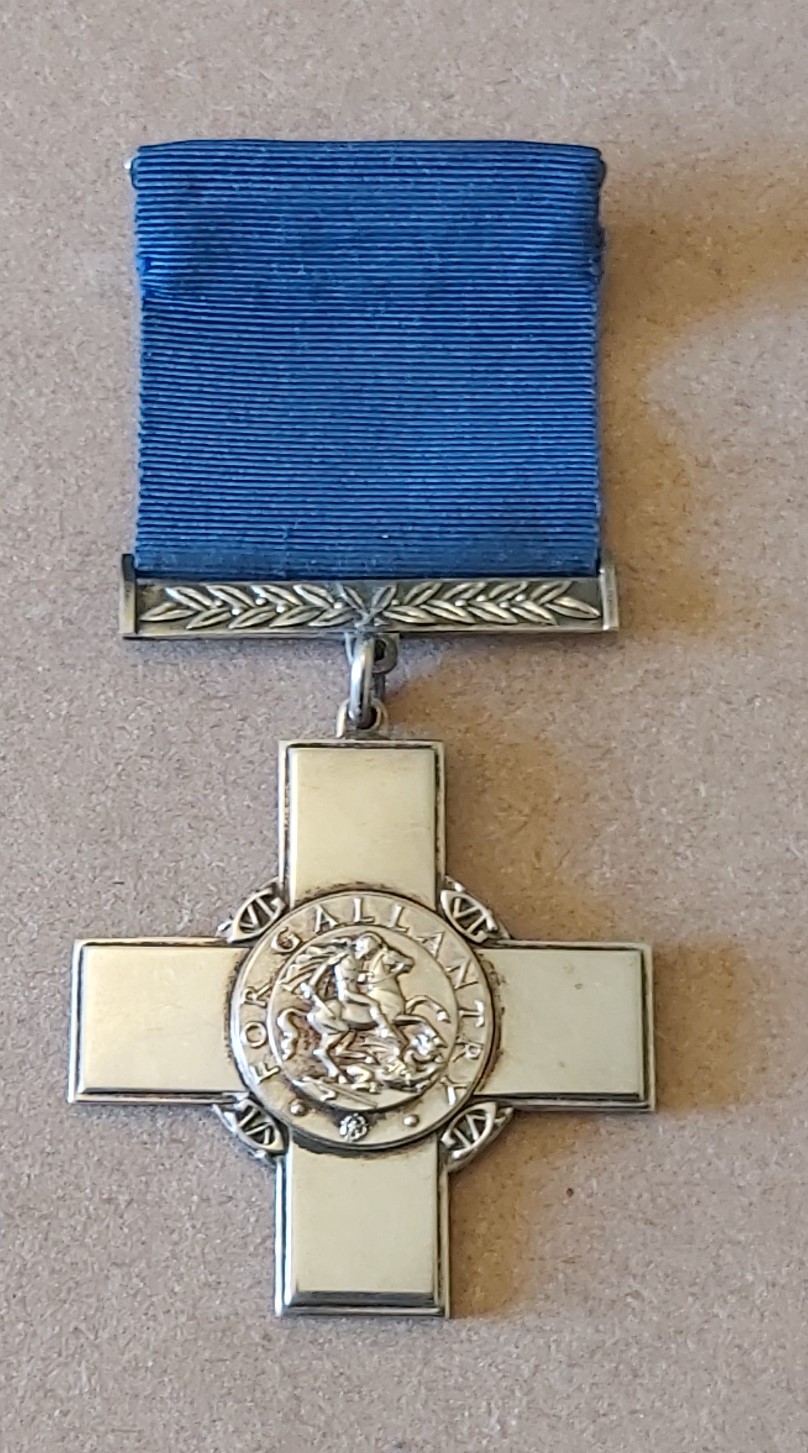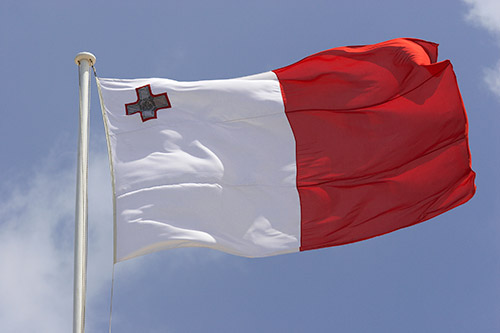The history of the George Cross
What is the George Cross? British honours expert Russell Malloch looks at the history of the George Cross and some of its recipients.

What is the George Cross?
The George Cross, which was conferred on the National Health Service (NHS) on 5 July 2021 (Gazette issue 63406), is the UK’s highest award for acts of heroism or courage in circumstances of extreme danger, other than those performed in the face of the enemy (in which case the Victoria Cross may be granted).
When was the George Cross instituted?
The George Cross was instituted by King George VI in 1940 at a time of great difficulty for the nation, following the failure of the military campaign in Norway, the German advances into Denmark and the Netherlands, and the fall of France. The British Expeditionary Force was forced to evacuate from Dunkirk, and The Gazette had reported the honours connected with the withdrawal to England “under fire and in the face of many and great difficulties” of 335,490 men of the allied armies in May and June of 1940 (Gazette issue 34867).
The nation then faced the Battle of Britain, and the Luftwaffe’s assault on London that began in early September. The bombing of Buckingham Palace created a bond between the King and the country, and before the end of the month he broadcast to the British Empire from an underground shelter, where he reflected on what had happened since the start of the war in 1939:
“Great nations have fallen. The battle, which was at that time so far away that we could only just hear its distant rumblings, is now at our very doors. The armies of invasion are massed across the Channel, only 20 miles from our shores. The air fleets of the enemy launch their attacks, day and night, against our cities. We stand in the front line, to champion those liberties and traditions that are our heritage.”
The King praised the work of the air raid services, and continued:
“The devotion of these civilian workers, firemen, salvage men, and many others in the face of grave and constant danger has won a new renown for the British name. Those men and women are worthy partners of our armed Forces and our police – of the Navy, once more as so often before our sure shield, and the Merchant Navy, of the Army and the Home Guard, alert and eager to repel any invader, and of the Air Force, whose exploits are the wonder of the world.”
The contributions of those labouring in factories and on the railways, regardless of dangers and the sirens sounding was acknowledged, as was the honour due to those who night after night endured discomfort, hardship and peril in their homes and shelters. The King then turned to a tangible form of recognition:
“Many and glorious are the deeds of gallantry done during these perilous but famous days. In order that they should be worthily and promptly recognized I have decided to create at once a new mark of honour for men and women in all walks of civilian life. I propose to give my name to this new distinction, which will consist of the George Cross, which will rank next to the Victoria Cross”.
What is the George Cross awarded for?
The founding royal warrant of 24 September 1940 explained that the decoration was “only for acts of the greatest heroism or of the most conspicuous courage in circumstances of extreme danger” (Gazette issue 35060), and was “intended primarily for civilians and award in [the] military services is to be confined to actions for which purely military honours are not normally granted.”
The new decoration fitted into an existing honours system that included the Albert Medal and the Sea Gallantry Medal for rescue work at sea, the Albert Medal for similar acts on land, the Edward Medal for bravery in mines and industrial settings, and the Empire Gallantry Medal for more general use.
The founding warrant provided that the Empire Gallantry Medallists should instead become holders of the George Cross. More than 120 Empire Gallantry Medal awards were gazetted before the King’s broadcast, and while some of the medallists had died by September 1940, more than 100 lived to receive the George Cross. A similar provision for the surviving holders of the Albert and Edward Medals was introduced, but not until December 1971 (Gazette issue 45566).
Who designed the George Cross?
The George Cross was designed by Percy Metcalfe, and consisted of a plain silver cross, with a central medallion showing St George and the dragon within the words “For Gallantry” and with the royal cypher (G VI) placed between the limbs of the cross. The reverse was plain and is usually inscribed with the recipient’s name and the date of the award.
The Cross shown here was presented to the family of Bertie Crosby, who had received the Edward Medal after sustaining life-threatening burns when, at the age of 16, he tried to rescue a colleague following a fire that led to the death of several workers at a film processing factory (Gazette issue 33384).

Who has received the George Cross?
Early recipients
The names of the first recipients of the George Cross were published in The Gazette on 30 September 1940 (Gazette issue 34956), starting with Thomas Alderson who helped to rescue people from houses that were demolished by an enemy air raid on Bridlington. The same Gazette announced the honour for Lieutenant Robert Davies and Sapper George Wylie of the Royal Engineers for recovering a bomb that fell near St Paul’s Cathedral in London.
King George VI conferred the Cross on 114 individuals, and details of their names and acts of gallantry were usually placed in the official public record. The only award that was not gazetted related to Malta, after the island was decorated in 1942 “to bear witness to a heroism and devotion that will long be famous in history”. However, The Gazette did report the warrant that added the decoration to Malta’s armorial bearings (Gazette issue 36393), with the result that the islanders’ war-time heroism is remembered today by the George Cross that appears on the Maltese national flag.
Most of King George’s home awards (as opposed to Commonwealth) related to hazardous work, and the rescue efforts of members of the armed forces. The Gazette also reported acts of bravery by men and women who were tortured during the war, with posthumous George Crosses from 1946 awarded to:
- John Fraser (Gazette issue 37771), the assistant attorney general of Hong Kong who organised escape plans from a Japanese internment camp
- Sergeant Arthur Banks (Gazette issue 37776), of the Royal Air Force Volunteer Reserve who was shot through the head by Italians fascists
- Violette Szabo (Gazette issue 37820), who was parachuted into France to undertake a particularly dangerous mission and was captured, then tortured, and finally executed by the Gestapo
Queen Elizabeth II
Only 33 home awards of the George Cross were made during the reign of Queen Elizabeth II, excluding two grants in favour of organisations, with the NHS distinction preceded by the Royal Ulster Constabulary which was noticed in 1999 for being “the bulwark against, and the main target of, a sustained and brutal terrorism campaign.”
There were several Commonwealth awards, including the first recipient of the present reign, which was conferred in April 1952 on the advice of the Queen’s Australian ministers on George Taylor, a volcanologist whose work saved many lives following the violent eruption of Mount Lamington in Papua and New Guinea (Gazette issue 39519).
Some of the civilian awards were posthumous, as in the case of David Broadfoot (Gazette issue 39979), a radio officer who went down with the MV Princess Victoria off the coast of Northern Ireland after it was struck by heavy seas, while Barbara Harrison, a stewardess with British Overseas Airways, gave her life to help passengers escape from an aircraft that had caught fire and crashed soon after take-off at Heathrow Airport (Gazette issue 44913).
The decoration was usually presented by the Queen, whose first George Cross ceremony was held at Buckingham Palace on 17 February 1953 when she invested Sergeant Frederick Fairfax of the Metropolitan Police for bravery in tackling armed criminals at a warehouse in Croydon (Gazette issue 39746).
One notable investiture, involving another Metropolitan Police officer, took place on 26 November 1974 when the Queen presented the Cross to Inspector James Beaton (Gazette issue 46354), who was wounded during an attempt to kidnap Princess Anne in central London in March 1974. The incident earned two individuals the George Medal, which was instituted at the same time as the George Cross to mark less conspicuous acts of bravery, and three awards of the Queen’s Gallantry Medal, which was created in 1974 to provide a third level of recognition.
15 crosses were conferred on the military services during the Queen’s reign in circumstances where the Victoria Cross was not appropriate, as with Second Lieutenant Michael Benner of the Royal Engineers (Gazette issue 41421), who sacrificed his life to save a colleague during a mountaineering accident on the Grossglockner in Austria, while Lance Corporal Matthew Croucher of the Royal Marines Reserve (Gazette issue 58774) risked his life in a deliberate act of self-sacrifice to save comrades from death or serious injury when a grenade detonated beside their team during an operation in Helmand Province in Afghanistan.
The Queen’s words from 2021, when she conferred the George Cross on the NHS for supporting the people of the United Kingdom “with courage, compassion and dedication, demonstrating the highest standards of public service,” clearly recalled her father’s words from 1940 when he praised the devotion of civilian workers, firemen, salvage men, and many others in the face of grave and constant danger, who were “alert and eager to repel any invader”, which has more recently been a deadly virus rather than the Luftwaffe.
About the author
Russell Malloch is a member of the Orders and Medals Research Society and an authority on British honours.
See also
This month in history: Malta's George Cross
The Order of the British Empire (part one): 1917 to 1922
What is a Companion of Honour and who holds the title?
Images
Russell Malloch
Getty Images
Publication updated: 17 May 2023
Any opinion expressed in this article is that of the author and the author alone, and does not necessarily represent that of The Gazette.
